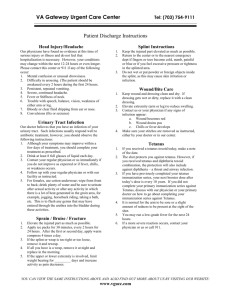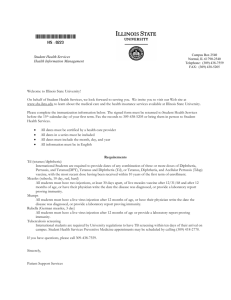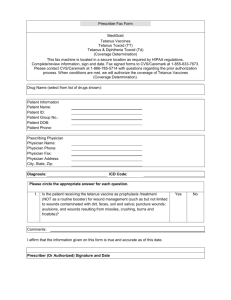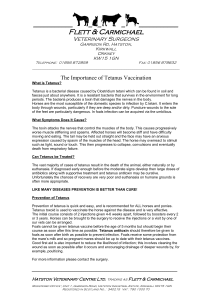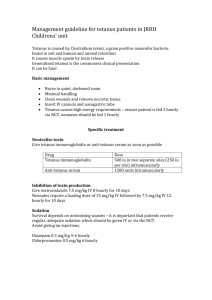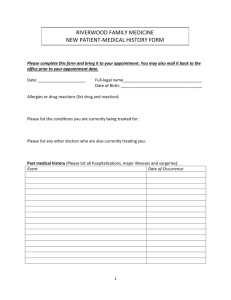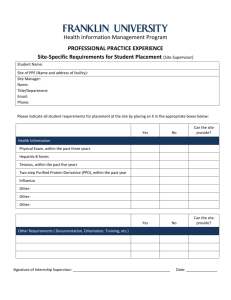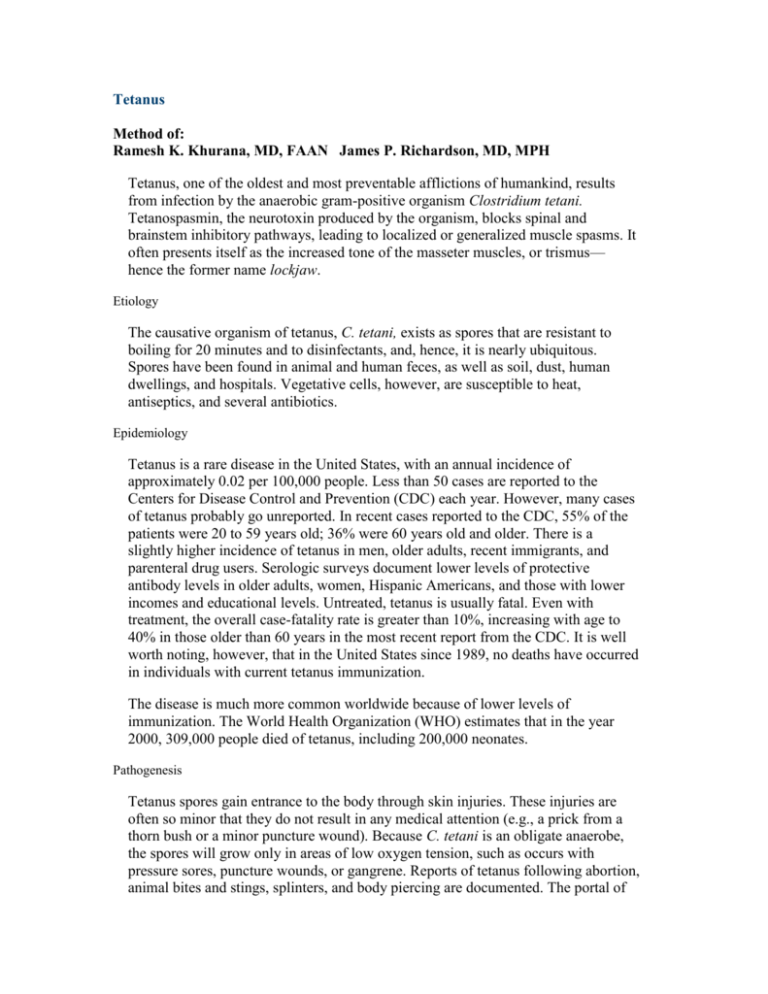
Tetanus
Method of:
Ramesh K. Khurana, MD, FAAN James P. Richardson, MD, MPH
Tetanus, one of the oldest and most preventable afflictions of humankind, results
from infection by the anaerobic gram-positive organism Clostridium tetani.
Tetanospasmin, the neurotoxin produced by the organism, blocks spinal and
brainstem inhibitory pathways, leading to localized or generalized muscle spasms. It
often presents itself as the increased tone of the masseter muscles, or trismus—
hence the former name lockjaw.
Etiology
The causative organism of tetanus, C. tetani, exists as spores that are resistant to
boiling for 20 minutes and to disinfectants, and, hence, it is nearly ubiquitous.
Spores have been found in animal and human feces, as well as soil, dust, human
dwellings, and hospitals. Vegetative cells, however, are susceptible to heat,
antiseptics, and several antibiotics.
Epidemiology
Tetanus is a rare disease in the United States, with an annual incidence of
approximately 0.02 per 100,000 people. Less than 50 cases are reported to the
Centers for Disease Control and Prevention (CDC) each year. However, many cases
of tetanus probably go unreported. In recent cases reported to the CDC, 55% of the
patients were 20 to 59 years old; 36% were 60 years old and older. There is a
slightly higher incidence of tetanus in men, older adults, recent immigrants, and
parenteral drug users. Serologic surveys document lower levels of protective
antibody levels in older adults, women, Hispanic Americans, and those with lower
incomes and educational levels. Untreated, tetanus is usually fatal. Even with
treatment, the overall case-fatality rate is greater than 10%, increasing with age to
40% in those older than 60 years in the most recent report from the CDC. It is well
worth noting, however, that in the United States since 1989, no deaths have occurred
in individuals with current tetanus immunization.
The disease is much more common worldwide because of lower levels of
immunization. The World Health Organization (WHO) estimates that in the year
2000, 309,000 people died of tetanus, including 200,000 neonates.
Pathogenesis
Tetanus spores gain entrance to the body through skin injuries. These injuries are
often so minor that they do not result in any medical attention (e.g., a prick from a
thorn bush or a minor puncture wound). Because C. tetani is an obligate anaerobe,
the spores will grow only in areas of low oxygen tension, such as occurs with
pressure sores, puncture wounds, or gangrene. Reports of tetanus following abortion,
animal bites and stings, splinters, and body piercing are documented. The portal of
entry in the newborn is usually through the contaminated umbilical stump. Growing
or vegetative C. tetani organisms produce tetanospasmin, one of the most potent
neurotoxins known, which reaches the nervous system via two routes: blood-borne
delivery to peripheral nerves and retrograde intraneuronal transport. The toxin exerts
its effects on the peripheral nerves, neuromuscular junction, muscle, spinal cord,
brainstem, and possibly the hypothalamus.
Tetanospasmin is recognized by high-affinity receptors located on the surface of the
peripheral nerve endings, is internalized and retrogradely transported to the neurons
in the spinal cord and brainstem. The toxin then migrates transsynaptically to
presynaptic terminals and blocks the release of the inhibitory neurotransmitters
gamma-aminobutyric acid (GABA) and glycine. Loss of inhibition affects the alpha
motor neurons and preganglionic sympathetic neurons, producing muscle spasms
and autonomic hyperactivity, respectively. Recovery involves synthesis of new
presynaptic components and their transport to the distal axons.
Clinical Presentation
The incubation period of tetanus is usually from 3 days to 3 weeks, but tetanus can
occur several months after an injury. Cases with shorter incubation periods and rapid
generalization of spasms tend to be the most severe. There are three clinical forms of
tetanus based on the site of toxin action and the age of the patient: generalized,
localized, and neonatal.
Generalized disease is the most common of the forms ( Box 1 ). Typical presenting
complaints include trismus, neck rigidity, stiffness, dysphagia, restlessness, and
reflex spasms. Tetanus patients may display risus sardonicus (a characteristic
grimace manifested as raised eyebrows and a wrinkled forehead with the corners of
the mouth pulled up). Muscle rigidity usually starts with the jaw and facial muscles
and then spreads to the trunk (opisthotonos) and extensor muscles of the limbs.
Hands and feet are relatively spared. Spasms may occur spontaneously or may be
provoked by external stimuli such as noise, touch, lights, and parenteral injections.
Tetanic spasms differ from grand mal seizures in that patients with tetanic spasms
remain conscious. These spasms affect agonist and antagonist muscle groups
together and are extremely painful. Violent paroxysms of generalized spasms may
result in fractures, muscle rupture and rhabdomyolysis, and laryngospasm and
apnea, both of which preclude ventilation and feeding.
BOX 1
Presentation of Tetanus
Generalized Disease
Trismus
Risus sardonicus
Dysphagia
Opisthotonos
Isolated cranial nerve palsies
Rigidity or stiffness in an extremity
Neck stiffness
Restlessness
Tetanic seizures
Poor sucking (newborns)
Localized Disease
Rigidity or stiffness in an extremity
Cephalic Disease
Single or multiple cranial nerve palsies
Autonomic dysfunction usually complicates severe cases, occurring some days after
spasms. This dysfunction may be one of overactivity or underactivity of the
sympathetic and parasympathetic nervous systems. Sympathetic disturbances may
manifest as labile or sustained hypertension, tachycardia, dysrhythmia, peripheral
vasoconstriction, profuse sweating, glycosuria, and elevated plasma and urinary
catecholamines. Parasympathetic manifestations include profuse salivation,
increased bronchial secretions, gastric stasis, and ileus. Hypotension, bradycardia,
and cardiac arrest may occur.
Two less common types of tetanus are localized tetanus and cephalic tetanus.
Localized tetanus is characterized by painful spasms of muscles near the site of
injury. This disorder is usually self-limiting and lasts less than 2 weeks, but
progression to generalized disease can occur if untreated. Cephalic tetanus is a
frequently severe form of localized tetanus. The bacillus enters through minor head
trauma or chronic otitis media. Cephalic tetanus may present as single or multiple,
often unilateral, cranial nerve palsies before the development of trismus, dysphagia,
dysarthria, head tilt, and possible generalization.
Neonatal tetanus presents as an inability to suck and irritability 3 to 10 days after
birth. It is usually a generalized form characterized by muscle rigidity, opisthotonos,
apnea, and cyanosis.
Diagnosis
Tetanus is a clinical diagnosis; there is no specific confirmatory laboratory test. A
history of a predisposing injury in an inadequately immunized host is helpful. As
noted earlier, however, a history of injury is not always present. A well-documented
history of primary immunization and a booster immunization within the last 10 years
makes the diagnosis of tetanus less likely. The diagnosis is based on the observation
of characteristic clinical features. Apte and colleagues, in administering a spatula
test to diagnose tetanus, observed that 94% of 359 patients with tetanus involuntarily
bit the spatula because of the reflex spasm of masseter muscles, instead of gagging
and expelling it. Absence of sensory deficits and a clear sensorium supports the
diagnosis of tetanus. Laboratory tests such as complete blood counts and routine
blood chemistry tests are not helpful. Creatine kinase may be elevated. Cultures are
positive in only 32% to 50% of patients, and, in any event, treatment cannot wait for
their completion. Tetanus antitoxin antibody levels are not usually available quickly
and are not reliable after the administration of human tetanus immune globulin
(HTIG). Electromyography of the involved muscles, or the masseter muscle, shows
continuous motor unit discharge. Laboratory tests can, however, be useful in
excluding other conditions. For example, a urine screen may be positive in cases of
strychnine poisoning.
CURRENT DIAGNOSIS
▪
The diagnosis is clinical; laboratory tests are not helpful, except in
eliminating other diagnoses.
▪
A history of adequate tetanus immunization makes the diagnosis much less
likely.
▪
Involuntary biting of a spatula because of masseter muscle spasm is highly
suggestive.
▪
Generalized disease is the most common form of tetanus and may present as
trismus, neck rigidity, stiffness, dysphagia, restlessness, reflex spasms, and
risus sardonicus.
Established generalized tetanus is easily recognized, whereas the diagnosis of
cephalic tetanus can pose some difficulty. Cranial nerve involvement is common and
may confuse the physician. Trismus may result from intraoral disease or an acute
dystonic reaction to phenothiazines or metoclopramide (Reglan). Muscular stiffness
can also be a manifestation of strychnine poisoning, meningitis, hepatic
encephalopathy, rabies, hypocalcemic tetani, stiff-man syndrome, and conversion
reaction. A delay in the diagnosis of tetanus has occurred in patients presenting with
dysphagia. Rigid abdominal muscles may simulate an acute abdomen.
Treatment
Whenever possible, patients with suspected tetanus should be transferred to a facility
that has experience with this disease. Patients should be kept in a quiet and dark
environment to minimize sensory stimulation. Treatment has the following goals:
•
Neutralization of the circulating toxin that has not yet entered the nervous
system
•
Elimination of the source of the toxin by careful surgical débridement and by
antibiotic administration to inhibit growth of the bacilli
•
Prevention of respiratory and metabolic complications
•
Prevention of muscle spasms
•
Management of cardiovascular complications caused by autonomic instability
Tetanus antitoxin should be given to prevent further fixation of the toxin to the
central nervous system, although it will not reduce manifestations already present.
Between 3000 and 6000 units of HTIG (or Hyper-Tet) should be given
intramuscularly as soon as possible and definitely before manipulating the wound.
Some authorities recommend giving some of the HTIG near the site of the wound.
Tetanus does not confer immunity. Therefore, active immunization with tetanus and
diphtheria toxoid (Td) or diphtheria toxoid–pertussis vaccine–tetanus toxoid (DPT)
or DTaP, as appropriate, also should be given, at a site contralateral from that for
tetanus immune globulin (TIG) ( Table 1 ).
TABLE 1 -- Routine Diphtheria and Tetanus Immunization Schedule for Persons 7
Years of Age and Older
Dose
Age/Interval
Product
Primary 1 First dose
Td
Primary 2 4–8 weeks after the first dose[*]
Td
Primary 3 6–12 months after second dose[*] Td
Boosters Every 10 years after last dose
Td
From Immunization Practices Advisory Committee: Diphtheria, tetanus, and pertussis:
Recommendations for vaccine use and other preventive measures-recommendations of
the Immunization Practices Advisory Committee (ACIP). MMWR 1991;40(No. RR-10).
Abbreviation: Td = tetanus and diphtheria toxoid.
*
Prolonging the interval does not require restarting series.
CURRENT THERAPY
▪
Tetanus antitoxin[2] and/or human tetanus immune globulin (BayTet) should
be given immediately, followed by débridement and appropriate antibiotic
therapy (e.g., metronidazole [Flagyl]).
▪
Tetanus immunization with tetanus and diphtheria toxoid (Td) should also be
given.
▪
Tetanic spasms should be controlled with benzodiazepines.
▪
Fentanyl (Sublimaze)[1] may help control autonomic cardiovascular
instability (manifested as hypertension and tachycardia) by attenuating the
sympathetic efferent discharge.
▪
Supportive care includes protection of the airway, management of fluids and
electrolyte balance, nutrition, bowel and bladder functions, skin care, deep
venous thrombosis prophylaxis, and physiotherapy.
2 Not available in the United States.
1 Not FDA approved for this indication.
Débridement is important for several reasons. It removes live organisms, creates an
aerobic environment unfavorable for further growth, and secures specimens for
culture. Débridement should be delayed until several hours after the administration
of antitoxin because tetanospasmin may be released into the bloodstream. Antibiotic
therapy is essential to sterilize the wound and eradicate the bacilli in their vegetative
form. The antibiotic of choice is metronidazole (Flagyl), given at a dose of 7.5 mg
per kg every 6 hours up to a maximum of 500 mg. Acceptable alternatives are
doxycycline (Vibramycin) and imipenem cilastatin (Primaxin).[1] Penicillin, once the
drug of choice, should not be used because it acts as a competitive antagonist to
GABA and promotes hyperexcitability and convulsions.
Oxygenation is ensured by protecting the airway. In all but the mildest of cases,
prophylactic intubation should be initiated early. Intubation will usually require
sedation with a benzodiazepine (e.g., lorazepam [Ativan],[1] 2 mg intravenously) and
neuromuscular blockade (e.g., vecuronium [Norcuron], 0.08 to 0.1 mg per kg).
Patients in whom orotracheal intubation precipitates laryngeal spasms, require more
than 10 days of intubation, or have generalized seizures should undergo elective
tracheostomy. An oropharyngeal airway will allow removal of secretions and
prevent biting in mild cases that do not require intubation.
Control of tetanic spasms and rigidity is best achieved with the benzodiazepines.
Additional benefits are that these drugs produce sedation and amnesia. Diazepam
(Valium)[1] can be given at a large dose of 0.5 mg per kg to 15 mg per kg per day[3]
intravenously. Alternatively, continuous infusions of lorazepam (Ativan) at a dose of
0.1 to 2.0 mg per kg per hour,[3] midazolam (Versed)[1] at a dose of 0.01 to 0.10 mg
per kg per hour, or propofol (Diprivan)[1] at a dose of 3.5 to 4.5 mg/kg per hour can
be given. The intrathecal administration of baclofen (Lioresal)[1] has been found
useful, but it is both costly and invasive.
In patients whose muscle spasms do not respond to sedation, neuromuscular
blocking agents, such as vecuronium (Norcuron),[1] are often necessary. The patients
will require assisted ventilation, often for several days or weeks. Because
neuromuscular agents prevent skeletal muscle movements only and do not reduce
pain or provide sedation, it is essential that patients be monitored very closely for
adequate pain relief.
Later in the course of the disease, autonomic cardiovascular instability may develop.
Both morphine[1] and fentanyl (Sublimaze)[1] may control hypertension and
tachycardia by attenuating the sympathetic efferent discharge. Fentanyl
(Sublimaze)[1] is considered superior because it does not depress myocardium.
Previously used agents phentolamine (Regitine) and metoprolol (Lopressor) for
treatment of hypertension and tachycardia are no longer recommended. Hypotension
induced by phentolamine may be difficult to reverse, and β-adrenergic blockers may
contribute to cardiac failure and high mortality. Hypotension may require
monitoring of cardiac output and intravenous fluids or pressor agents. Bradycardia
may develop, requiring placement of a pacemaker.
3 Exceeds dosage recommended by the manufacturer.
Complications
Supportive care is critical to the prevention of complications. It includes
management of fluids and electrolyte balance, nutrition, bowel and bladder
functions, skin care, and physiotherapy. Most of the complications are those that are
common to immobile patients. Frequent turning of the patient will prevent pressure
sores. Low-dose heparin or enoxaparin (Lovenox) should be administered to prevent
deep venous thrombosis and formation of pulmonary emboli. Physical therapy
should be given as soon as possible to prevent contractures. Orthopedic management
may be required for fractures and dislocations resulting from tetanic seizures.
Prognosis
The severity of illness, age of the patient, and the facilities available are the most
important factors determining prognosis. In the developing world where mechanical
ventilation is unavailable, asphyxia is the most common cause of death. Those who
survive the acute phase may succumb to autonomic dysfunction. With expanding
facilities for intensive care, most patients eventually make a full recovery over 4 to 6
weeks, but some patients remain hypertonic; some patients remain amnestic for the
event, whereas others have unpleasant memories of painful tetanic spasms,
physiotherapy to the chest, and tracheal suction. Tracheal stenosis as a sequel to
prolonged intubation and tracheostomy is common. It is important that recovering
patients complete a primary series of immunizations because having had the disease
does not confer immunity ( Table 2 ).
TABLE 2 -- Guide to Tetanus Prophylaxis in Routine Wound Management
History of Adsorbed Tetanus Toxoid
Clean, Minor
All Other
(doses)
Wounds
Wounds[*]
Td[†]
TIG[†]
Td[†]
TIG[†]
Unknown or
<Three
Yes
No
Yes
Yes
≥Three[‡]
No[§]
No
No[II]
No
From Immunization Practices Advisory Committee: Diphtheria, tetanus, and pertussis:
Recommendations for vaccine use and other preventive measures—recommendations of
the Immunization Practices Advisory Committee (ACIP). MMWR 1991;40(No. RR-10).
Abbreviations: DT = pediatric diphtheria and tetanus toxoid; DTaP = diphtheria and
tetanus toxoid and acellular pertussis vaccine; DTP = diphtheria and tetanus toxoid
and whole-cell pertussis vaccine; Td = tetanus and diphtheria toxoid; TIG = tetanus
immune globulin; TT = tetanus toxoid.
*
Such as, but not limited to, wounds contaminated from dirt, feces, soil, saliva; puncture wounds; avulsions; and wounds
resulting from missiles, crushing, burns, or frostbite.
†
For children under 7 years old, DTaP, DTP, or DT if pertussis vaccine is contraindicated is preferred to TT alone. For
persons 7 years of age and older, Td is preferred to TT alone.
‡
If only three doses of fluid toxoid have been received, a fourth dose of toxoid, preferably an adsorbed dose, should be
given.
§
Yes, if more than 10 years since last dose.
II
Yes, if more than 5 years since last dose. (More frequent boosters are not needed and can accentuate side effects.)
Prevention
Prevention of tetanus through immunization is the key to the elimination of tetanus.
It is useful to distinguish between primary and booster immunization. A patient 7
years old or older who has never been immunized requires two additional doses of
Td beyond that given when the wound is treated (see Table 2 ). Wounded patients
who have never been immunized may require HTIG (see Table 1 ). The elderly are
particularly susceptible if they have never been immunized or if their immunity has
lapsed. The American Academy of Pediatrics now recommends that adolescents 11
to 18 years of age receive a single dose of Tdap (tetanus toxid, reduced diphtheria
toxid, acellular pertussis vaccine) for booster immunization to prevent pertussis (in
addition to tetanus and diphtheria) in this population. Those adolescents who have
received Td but not Tdap should receive a single dose of Tdap after a suggested
interval of at least 5 years to reduce the risk of adverse reactions.
Physicians should use a case-finding approach to increase tetanus immunization
rates. System changes (such as clinical pathways that allow immunization without a
physician's order) are the most effective means of increasing immunization rates.
Reminders placed at physicians' desks or computer-generated reminders attached to
charts or patients' bills have also increased immunization rates. Td should be given
whenever tetanus immunization is necessary to ensure immunity to diphtheria as
well as to tetanus.
Td is a safe vaccine. Adverse reactions consist primarily of local edema, tenderness,
and fever. Anaphylactoid reactions are rare. Most adverse reactions occur in persons
with evidence of hyperimmunization. The only contraindications of Td are a history
of a neurologic sequela or a severe hypersensitivity reaction following a previous
dose.
To reduce neonatal tetanus and protect the mother, pregnant women who are due for
a booster should receive Td, preferably during the last two trimesters. HTIG should
be given to pregnant women only when clearly indicated. The WHO recommends
that women attending prenatal clinics in developing countries be given two doses:
•
During the first pregnancy
•
In the third trimester at least 4 weeks before delivery
These should be followed by one dose in each subsequent pregnancy, up to a total of
five doses. Needless to say, promoting clean delivery and hygienic cord care
practices constitutes a key element in the prevention of neonatal tetanus.
Copyright © 2007 Elsevier Inc. All rights reserved. - www.mdconsult.com
Bookmark URL: /das/book/0/view/1444/81.html

